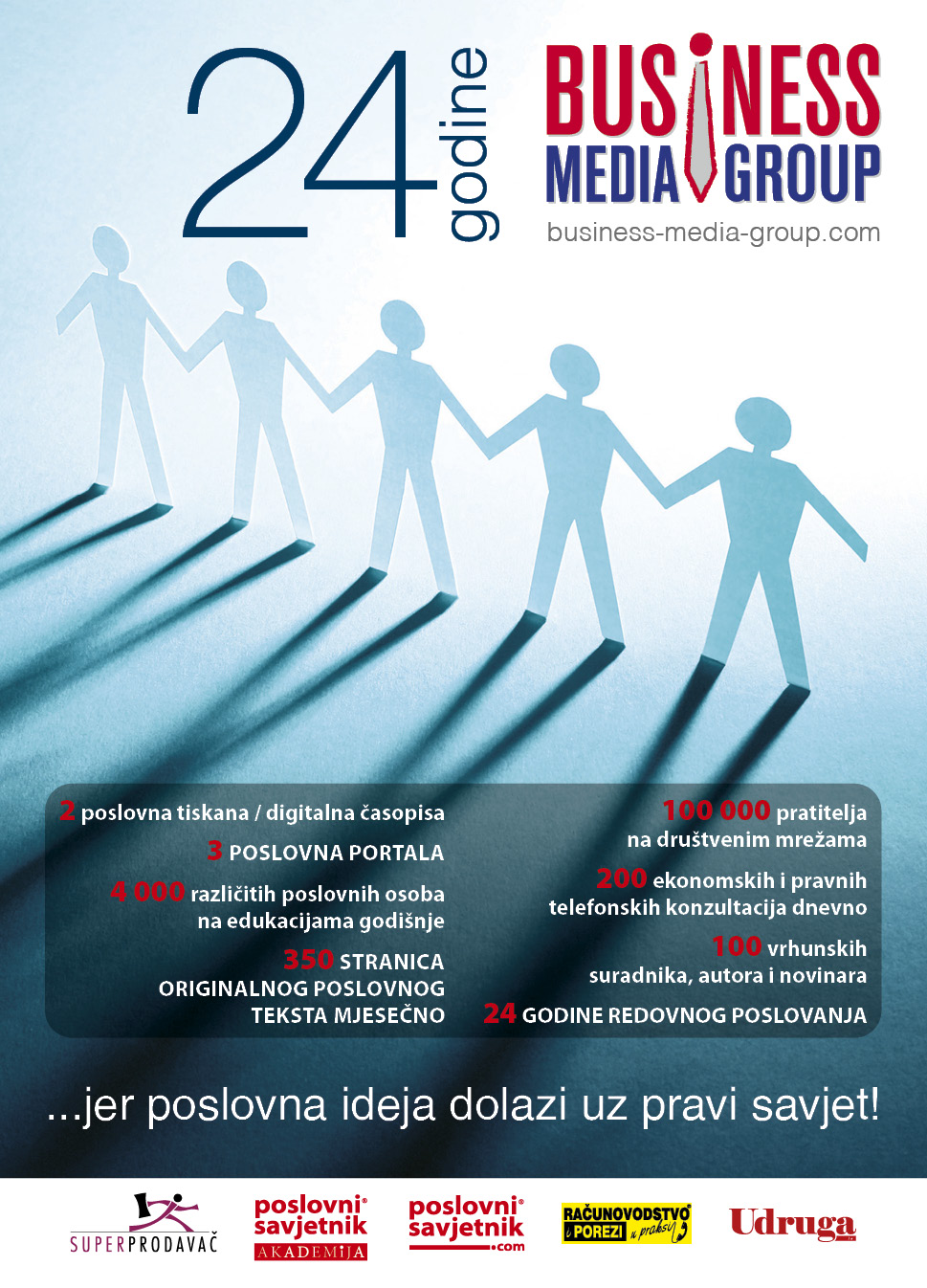John Lodder: What Effective Leaders Should Not Do

In ‘Leadership First’ I read: ˝It’s quite amazing that people who call themselves “managers” will create an environment of fear to get people to work.
All the research in the world has proven that fear based leadership or management does not work; it may result in short-term gain but the quality of work will be average at best, but never sustainable in the long run.
Leadership is not about welding authority or creating an environment of fear, it’s all about empowering people and empowering your team(s) to become the very best version of them.˝
‘Usual’ management and Leadership literature writes about what leaders should do to grow or to become (more) successful. Subjects are ‘usual’ about how to implement positive, strengths-based, and solution-oriented aspects of the HUMAN Futures of Work and Working. I realized that sharing what NOT to do is also relevant to shed light on aspects of the business-as-usual that needs to transform.
Throughout my August column I ask several self-reflective questions, just to challenge or to warn you upfront! I start with a view on the global ‘Quite Quitting’ trend and present a few Not to Do’s which then brings me to the subject of motivation. Next I present 19 signs of a neglected organization you could use as a checklist for your own company culture. Business leaders also need to change their behavior if they want to implement change(s) in their organization, I show 3 pitfalls you should avoid.
Global trend: Doing the absolute minimum at work
Doing just enough at work to stay, leaving on time and not checking e-mails at home but relaxing.More and more people ‘just do their job’ and not more than that. This is a global trend caused by low job satisfaction and fueled by the pandemic, writes the Guardian on August 6:
Quiet quitting: why doing the bare minimum at work has gone global | Work & careers | The Guardian
‘Quite Quitting’ has a link to the elements that are perhaps more negative: mentally checking out from a job, being exhausted from the volume of work and lack of work-life balance that hit many of us during the pandemic. And that can lead to less satisfaction at work, lack of enthusiasm, less engagement.
So we could compare ‘quiet quitting’ with ‘the great resignation’. Do we stay put but switch off? Or do we move towards something?
The meaninglessness of modern work and the workplace has led many people to question their approach to their jobs. Maria Kordowicz, professor in organizational behavior at the University of Nottingham said the rise in ‘quiet quitting’ is linked to a noticeable fall in job satisfaction.’ Since the pandemic people’s relationship with work has been studied in many ways, and the literature typically, across the professions, would argue that yes, people’s way of relating to their work has changed,” Kordowicz said.
“The search for meaning has become far more apparent. There was a sense of our own mortality during the pandemic, something quite existential around people thinking: ‘What should work mean for me? How can I do a role that’s more aligned to my values?’
Dr. Ashley Weinberg, psychologist at the University of Salford says: ˝As an employer it is important to create jobs that provide control and pride with the employees. Fair salary should be part of that. People talk about money and that is very important. But people also need respect for what they do and they want to be valued in one way or another.
Perhaps “quiet quitting” has been brewing for a while after all. More recently, tech firms have capitalized on the reaction against the 1980s long-hours culture by creating more casual working environments with brightly colored offices, free food and drink and corporate swag, wrapped up in the rhetoric of mission and purpose.
Weinberg said: “If you’re committed to your career and feel an emotional bond with the organization or the career, then, if an event happens that violates the psychological contract, the unwritten expectations, that abuse our sense of whether we can trust the organization, a logic decision is to quit.”
Enlightened companies are designing jobs that give employees control, pride in their work and a fair wage, but those efforts are undermined by the cost of living crisis, and workers end up feeling shortchanged. People talk about money, and that’s important but beyond that, they want to be respected for what they do, and be valued in some way. (Ashley Weinberg)
In the Netherlands 1 of 4 employees want another job within 2 years from now. (GITP, MT-Sprout, 220810)
A higher salary, a lease-car or the latest phone are not enough to stay. Else Slegers, CEO of GITP says: ‘’Many companies have no idea what the motives of their people are. Latest research shows that it takes a company 6-8 months to find a new employee, so it’s of great importance for companies to keep people onboard.˝ According to Slegers people want to be ‘valued’, they want to ‘be seen’. Further employees find it important that the company invests in their development. ‘Autonomy’, to determine yourself where and when you work is another important reason to stay – or to leave.
Leaders DO NOT chair team meetings
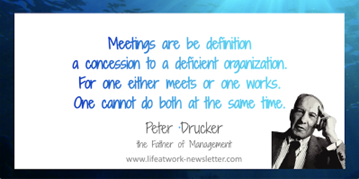
Many executives feel overwhelmed by meetings, and no wonder: on average, they spend nearly 23 hours a week in them, up from less than 10 hours in the 1960s. What’s more, the meetings are often poorly timed, badly run, or both.
- 15% of an organization’s time is spent in meetings, which has increased every year since 2008.
- Middle managers spend 35% of their time in meetings.
- Upper management spends 50% of their time in meetings.
- Employees spend 4 hours per week, preparing for status update meetings.
- 67% of employees complain that spending too much time in meetings hinders them from being productive at work.
- More than 35% of employees found that they waste 2 to 5 hours per day on meetings and calls.
(Shocking Meeting Statistics In 2021 That Will Take You By Surprise | Otter.ai)
Research based on 182 senior managers in a range of American industries concluded that 70% of all meetings are a waste of time. (Stop the Meeting Madness (hbr.org)
- 65% said meetings keep them from completing their own work.
- 71% said meetings are unproductive and inefficient.
- 64% said meetings come at the expense of deep thinking.
- 62% said meetings miss opportunities to bring the team closer together.
In the Netherlands managers meet on average 30 hours a week in 2020, remote working increased the number of meetings with 3 hours a week.
- Younger generations don’t want to be immersed in a meeting culture.
- 70% of 18-29 year olds find the free lunch the most exciting part of a meeting.
- 57% of employees and middle managers find meetings boring.
- Meetings cost ca. € 7, 000,- per employee per year.
(Nederlands onderzoek (https://www.sharp.nl/cps/rde/xchg/nl/hs.xsl/-/html/vergadering-op-vergadering-nederlanders-besteden-gemiddeld-bijna-dertig-uur-per-.htm)
Harvard Business Review (HBR) found that employee productivity was 71% higher when meetings were reduced by 40%. On top they found that employee satisfaction raised by 52%.
(https://hbr.org/2022/03/dear-manager-youre-holding-too-many-meetings).
How do you react when you receive an invitation for a team meeting?
> What are your experiences with team meetings?
> What are your low lights of energy-depleting gatherings?
> What are your highlights of energy-generating meet-ups?
Leaders facilitate team meetings
I find this flow chart offered by HBR helpful to decide if your meeting could have been an email:

Figure 1: Hold a meeting?
Leaders DO NOT track the time of their team members
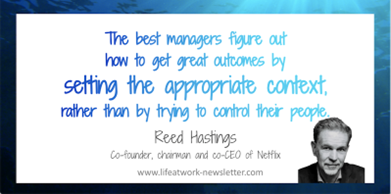
- Do you track your team members' working time?
- Do you track your own working time?
- What effect does this have on your productivity?
- What effect does this have on the quality of work?
- What effect does this have on your joy and satisfaction?
- What effect does this have on your motivation?
Time tracking is the first sign that a manager does not trust her/his employees !
Do you happen to watch Netflix? Have you ever looked at how they organize work and collaborate? They and many other enlightened companies stopped tracking working hours and additionally, Netflix also stopped tracking vacation time. WOW
One of their team members mentioned that tracking vacation days wasn’t in harmony with not tracking working time. This comment convinced the co-CEO and they dropped it. After this change, Netflix Leaders still need to remind their people to take their vacation time and to stop working to truly enjoy their holidays.
Get inspired by the Netflix Culture as an example at: https://jobs.netflix.com/culture
Leaders DO NOT take Feelings and Emotions to work
One of the business-as-usual ways of working, collaborating and doing business is to tell people to leave their feelings at home.
They are supposed to bring only the desired part (!) to work and neglect the rest. As if there were parts – we are participants! As if it was possible to separate your Self from your emotions and feelings.
On a scale from 0 to 10 (with 10 being the highest rating),
- How welcome are your feelings at work?
- How do you and your colleagues deal with each other’s feelings?
- What do you feel could be done more to bring your Self and your feelings fully in?
Feelings are contagious, even (or especially) when you try to suppress them or to separate them from yourself, they find a way to affect everyone around you. So the idea is to better take best care of your feelings and your Self. Feel encouraged to bring your whole Self into your team, your work, and your organization.
Mind, body, heart, and soul. Imagine how we could collaborate and what we could create with each other if we finally moved beyond focusing only on our cognition and be fully our Selves.
Just let me ask you four questions:
What quotes, proverbs, reactions, and assumptions are typically connected with people expressing
- anger?
- sadness?
- joy?
- fear?
I encourage you to take a moment NOT only to reflect on this question but also to take note of the thoughts, reactions, and resonances that come up for you. You might like to pause here before continuing your reading; certainly, this will deepen your insights and inspiration. This four-quadrant scheme will support you in your personal brainstorming:
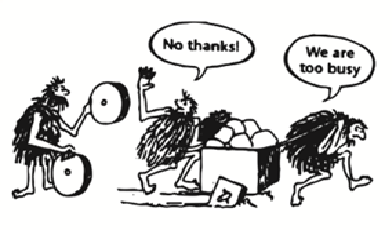
Figure 2: Map of 4 Feelings.
Maybe you have four quadrants full of rich reflections and thoughts regarding these four emotions.
They might contain ideas like the ones displayed in the following chart, now think about the potential benefits of these feelings have
Figure 3: Map of 4 Feelings

- How does this map resonate with you?
- Did you have similar thoughts? Additional ones?
- How do you feel after discovering this map of feelings?
The decision about feelings could be that the four feelings are neutral as the four dimensions on a compass. In this map, we are bigger than our feelings; we have the feelings instead of the feelings having us. Bring your feelings, emotions and your whole Self to work!
I like to remind you that often people begin a sentence with “I feel that…” however, usually, then they do NOT go on to express feelings or emotions as e.g. in “I feel inadequate”, “I feel ignored” or “I feel misunderstood”.
By aligning the pursuit of business objectives with the meeting of human needs, companies can tap into powerful emotional forces in their current cultural situations.
Imagine two call centers.
- In the first, you see smiles and concentrating faces, and overhear heartfelt efforts to help. There is a tangible buzz of hard work but also a feeling of energy and commitment.
- In the second call center, you see scowls, pained expressions, and eye rolls. Representatives carefully adhere to rote scripts, but their voices lack empathy and warmth. Despite frequent breaks and lags between calls, employees already seem exhausted halfway through the day.
If you compare your team’s energy and spirit with these call centers, to which of the 2 are you and your team similar or most alike?
The feelings present in a workplace, verbalized or not, largely determine employees’ motivation and ability to contribute. How people feel about their work is the most important determinant of success (or lack thereof) for any business. Feelings signal needs, and addressing or ignoring these needs in turn influences the feelings. By recognizing feelings, following them to needs, and acting to address the needs (engaging with what we call the feelings–needs link), organizations can consciously generate positive feelings and energy and create workplaces that are not only more pleasant, but dramatically more productive and successful.

Figure 4:
Feelings are messengers of needs. Meeting needs unlocks positive feelings and energy; neglecting needs does the opposite. By integrating business objectives with meeting people’s needs, companies can make sure the strong wind of a positive emotional force is at their back.
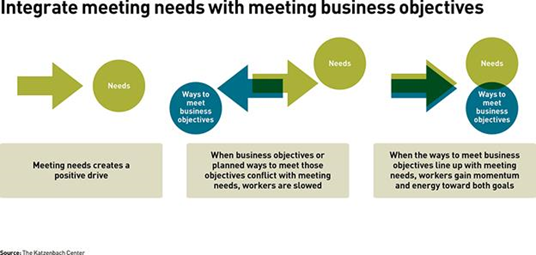
Figure 5:
Leaders DO NOT reward the ‘Employee of the Month
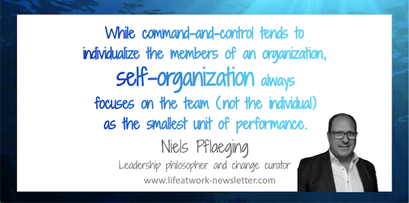
- Does your team or organization reward the Employee of the Month?
- What are your experiences with it?
- What effect does this have on your employees?
- What effect does it have on the team spirit?
- What effect does it have on the collaboration between employees?
We all know the photos of an ‘Employee of the Month’ framed at the entrance of a shop or the counter of a burger restaurant. Sometimes they even wear special name tags or t-shirts, indicating that they were the ‘chosen ones’. Often, when working with a team, the idea pops up to reward the Employee of the Month.
- The underlying intention is to motivate the whole team to strive toward this award.
- The myth is that people will increase their efforts, contribution and creativity to get the prize.
- Except they don’t.
Especially if they are knowledge workers, contributing their ingenuity and creativity to a purpose-driven organization.
More often than not the exact opposite happens: while individual goal-getters and ‘takers’ (as opposed to ‘givers’) might increase their efforts, team spirit and collaboration deteriorate dramatically.
Those who got awarded in the past month find themselves being singled out by their team members who leave it up to the top-performer to do her/his magic by her/himself.
“Aren’t you the Employee of the Month? Then get it done yourself !”
Imagine what would happen if all your team members individually strived for this title and recognition!
They would destroy the magic of COLLABORATIVE advantage and cultivate a ‘me, me culture’ instead.
Would you support someone who is about to become Employee of the Month while actually coveting the title yourself? If work becomes a rat race, a toxic dog-eat-dog culture, everyone against everyone, your beautifully displayed value of cooperation evaporates.
The trouble with the rat race is that even if you win, you're still a rat. (Lily Tomlin)

Figure 6: The ‘Rat Race’.
Why?
Because the Employee of the Month badge focuses on individual performance instead of team performance. In most professions, the results and outcomes of people’s work does NOT depend on the productivity or creativity of one single person, results and outcomes are co-created.
I think that even for sales people it’s not different. Would their sales numbers really, only be based on their personal efforts? My guess is that there are several efforts behind it (e.g. quality of the product or service, delivery by the post-sales team, customer services, testimonials of clients, etc.).
It might be safe to say that individual performance does not even exist. Boom.
So why do we keep awarding ‘Employees of the Month’ when this actually destroys our values, team spirit, and collaboration? Because we might not be fully aware of what truly motivates human beings resp. our employees.
Two thoughts about Motivation
1 – Dan Pink’s AMP-Formula
Dan Pink's animated video ‘’The surprising truth about what motivates us’’ enlightens in this regard.
He explains the magic AMP-formula: Authority, Mastery and Purpose.
Please watch his 11’ video at: https://youtu.be/u6XAPnuFjJc and then ask yourself 2 questions:
- Do your tasks provide enough AMP?
- How can you increase AMP for your employees?
2 – The Hertzberg motivation model
Figure 3 shows the differentiation between Herzberg’s Hygiene and Motivation factors.
- Hygiene Factors will not motivate people but if not handled well they cause Job DIS-satisfaction.
The most common mistake managers make in practice is that more salary or a financial bonus will increase the motivation of an individual. It does NOT !
A financial gift gives a temporary positive effect but it is not structural or long lasting.
- Motivation Factors motivate people in a structural way and cause Job-Satisfaction.

Figure 7: Herzberg’s Two Factor Theory
Reducing the hygiene factors reduces job DIS-satisfaction, while increasing motivation factors increases job satisfaction. Isn’t wellbeing and happiness of your employees the first and most important assignment of a Leader??
In Figure 8 you see some important Motivators or Satisfiers. As a leader you can increase the job satisfaction and motivation of your people by using these motivators in a consequent way. By keeping track of a ‘healthy’ level of the Hygiene Factors as a leader you can influence and prevent job dissatisfaction.
Every Leader should exchange regularly with her/his employee the status of their job satisfaction, you have the tools.
Figure 8: Herzberg’s Motivation and Hygiene factor model.

I encourage you to integrate these resources into your work as a Leader!
- What motivates you and your team members, personally and collectively?
- What demotivates you and your colleagues, personally and collectively?
- What inspires you all to contribute even more to your team’s and organization’s purpose?
- How might you increase each other’s Autonomy, Mastery and connection to the Purpose?
19 Signs of a neglected organization
Joost Kampen is a management consultant who recently got his PhD on a research about ‘neglected organizations’. He writes about numerous ‘neglected organizations’ in the world and what could be done about it. He gives 19 signs to recognize what’s not working well.
In my view this is another way of looking at an organization which could be ‘Food for Thought’ for managers and leaders! The question then is of course: ‘Do you recognize anything like this in your company?’
A neglected organization could look like this:
The meeting of the management team is on the agenda. The chairman isn't here, so you better start.
After 20 minutes he quietly strolls in, without apologizing. There are 18 items on the agenda for which 1 hour has been allocated. You won't make it.
Employees constantly check their mobile phones; deal with e-mails, sending text messages.
Every now and then a silly joke is made. An important decision has to be made. There is talk back and forth, but in the end it remains unclear what exactly has been decided. You get the impression that two employees are arguing – nobody says anything about it.
And at night you wonder why you are so exhausted.
(Do you recognize a couple of hygiene factors???)
A neglected organization, it sucks you dry
This is a typical example of a 'neglected organization', says Joost Kampen,
Every organization is developing, just like a child is developing. Leaders are there to guide that development.
Kampen: 'And if they don't do that properly, their employees will show the same behavior over time as that of neglected children. They become cynical, indifferent, dishonest and irresponsible; inwardly turn away from the matter. They start gossiping, lose respect for the leadership.
They become afraid of change and cannot cope with new demands.”
Symptoms of Neglect
When a new manager comes into a neglected organization, employees will start to resist.
- Sometimes openly, but more often in disguise.
- They boycott and sabotage all attempts to get things back on track.
- They complain about the new regime, make fun of it and spread poisonous rumors.
- They go into 'survival mode': everything has to stay the same, any change threatens their cocoon.
- It is an atmosphere that penetrates into the capillaries of the corporate culture.
But then: new staff who step in motivated, with integrity and in good spirits are also quickly infected with it.
The longer the neglect lasts, the more severe the symptoms. Just as neglected children learn to survive in the loveless climate of home, so too do the staff in a neglected organization, they learn to survive.
Spoiling Neglect
The cause is usually – just like with parents and neglected children – a lack of time and attention.
Kampen: 'If you literally don't have time for your employees, you lose contact.
• Are you constantly being sucked away from the primary process?
• Are you always busy with other things, not physically present at the workplace?'
Neglect is imminent.
Pampering Neglect
When parents compensate for their absence – out of guilt – with huge gifts and indulgence, we call it ‘pampering neglect.’
This also happens in companies. Some managers do not provide structure. They condone transgressive behavior. “To neglect pampering is always saying yes, being indulgent,” says Kampen.
Rewards are no longer in proportion to performance.
Or there are perverse incentives in it, as with many public organizations that have to deal with market forces.'
Self-managing teams in companies are often a form of neglect
Kampen often finds 'self-managing teams' a form of neglect.
‘A team that can handle a lot of independence is the final stage of a development path.
You can't start with that. Then it will be war, the law of the strongest will prevail and someone who wants to grow will not get a chance. Only when people can also address each other emotionally, there is that maturity.
Self-Managing Teams in practice are defined as:
People working in teams that are self-managing: the team members can choose how they do their work and are expected to make their own decisions. The Leader is expected to only look at the result, and above all facilitate the team by providing trust, space and resources. (R. van Solingen)
These are the 19 characteristics of a neglected organization
1. Many changes in management and senior management.
2. Low roll resistance: everyone interferes in everything.
3. The environment is uncared for..
4. Investment decisions are postponed.
5. Household processes, such as the reservation of a meeting room, are 'rattling' and cannot be put in order. 6. 'Dying on the Threshold' Plans: Everyone knows this and trusts it too.
7. There is a lot of noise and hassle around appointments.
8. Grumbling is common and refers to inability rather than a negative attitude.
9. Small events quickly become big stories.
10. Managers are often missing when you need them.
11. Measures are based on the worst-case scenario.
12. Punishment is usually not direct, but indirect.
13. There is a despondent atmosphere in (some) departments.
14. Action is taken regularly from above, at an unexpected moment.
15. It is always restless, cannot be explained by special circumstances.
16. There are many 'own shops' that no one knows the best about.
17. Official staff meetings are avoided by most staff.
18. Work and rest times are handled smoothly and management also maintains smooth.
19. Work and private life overlap: Relationships at work are common.
How do you restore a neglected organization?
#1 Build a good relationship
Here too, the comparison with upbringing sheds light on the matter. If foster parents have a neglected child in their home, a foundation must first be established, a relationship. It is no different in an organization. You achieve this by being approachable, by entering into confrontation, within a predictable structure.
#2 Take a few steps back and start over
Don't expect too much too soon; set your goals – at a performance level – low initially.
You have to take a few steps back and fix it where it went wrong.
For example: There have been no performance reviews for three years. Then we'll start again.
Or: The work meetings are regularly canceled. We don't cancel anymore! We may make it an hour shorter, but we have work meetings every week, so that people can ask their questions.
Or: Not keeping track of knowledge? That may have been deadlocked for a long time, but start again.
That is a recovery approach.
#3 Don't haggle
It can take 1 or 2 years, he knows from experience, before the recovery starts to bear fruit. But then it comes decisively. “Only when people realize that they can no longer get away with it, the neglect gradually passes.
It’s a matter of perseverance, despite all kinds of fierce reactions.
Don't haggle. Don't think: it's also pathetic. Expect normal, acceptable behavior.
But don't immediately rush them with performance pressure.'
#4 Differentiation is important
And there is another concept from upbringing that helps: differentiation.
“I have three children and every child is different,” Kampen says. ‘’What one child needs, another doesn't need. That is also the case in organizations.'’
If you make an appointment with two people as a team manager, you may know that one employee finds this more difficult than the other, because he doubts himself a lot. Then you visit the first one in the morning: is there anything else you want to know? You don't have to do that with the other person.
That is differentiation and that happens very rarely in organizations.
#5 Immerse yourself in your people
No wonder: to get to know all your employees, you have to observe their behavior and also name it for yourself. That's a lot of work. But that is precisely the job of a leader, says Kampen. “You have to immerse yourself in people. Not in their private affairs, please don't. But their behavior at work: how do they deal with it, what do they find difficult, what do they not? What do they need? That's what it's about.'
This is how trust building works
For his dissertation Kampen measured the return of confidence.
“First, trust in the immediate supervisor returns and then trust in senior management and only in the third instance in the organization as a whole. At least if there hasn't been a change at the top in the meantime, the top shouts all kinds of things and the employees sit back again, like okay… Then the trust is gone in no time.”
3 Pitfalls managers should avoid in a change process
In these times of disruptions change, transformation or reinvention is becoming a nearly daily routine in most organizations. That is clear. Such changes also require a change in staff behavior.
And that's where it often goes wrong. The cause? These three common pitfalls.
As a leader, you face the challenge of adjusting the behavior of a group of employees.
Following classical management lessons you quickly start drawing up new processes and control measures.
But you're not there yet.
The trick is to influence behavior in a pleasant, respectful way so that everyone stays involved and motivated. But how do you do that? Prof. Dr. Jan de Vuijst (TIAS Business School) has some tips.
1. You offer no or insufficient perspective
As a leader, it is crucial that you offer employees perspective. With a clear vision, you give colleagues the feeling that there is coherence in the work you do. That is important in our individualized society.
People want to feel involved and to be part of the big story. Also in the organization they work for.
A lack of such a perspective creates uncertainty.
Tip: take away the uncertainty
There is a great risk that you will confuse the uncertainty of employees with lack of clarity.
Jan de Vuijst: 'You may even be explicitly asked for a clearly elaborated plan or detailed agreements.
But that doesn't take away the uncertainty for the long term and those questions keep coming back.'
According to the professor, it is more effective to indicate, for example, that you cannot foresee exactly what is going to happen, but that you will inform everyone as soon as you know more.
The uncertainty remains, but everyone knows how things stand.
2. You lack self-reflection
There are leaders who were genuinely concerned about a feeling of insecurity or insecurity in the group, but they did not realize that they themselves played an important role in this.
That is why reflection on your own behavior and emotions is so important, says De Vuijst. It has long been known that self-reflection is a characteristic of a good leader. The ancient Greeks and Romans already wrote a lot about it.
Tip: find a sparring partner
De Vuijst therefore recommends that you regularly consult with a reliable sparring partner.
Find a well-trained executive coach who also has experience in leadership. Such a person can hold up a mirror to you well.
That helps to think critically about your behavior, its impact on the people you lead, and how you can improve yourself in this.
3. Above all you want to create a good team
A strong team with a common goal is very valuable, but also vulnerable.
De Vuijst: ‘Especially in a close-knit group, the need for cohesion is always subtly threatened.
People want to stay in it, but the danger of falling out is always lurking.”
The main question then is how well employees can deal with this tension. It takes a lot of time to build a relationship of trust before people really dare to be critical of each other.
And all that is necessary to get a strong and successful team.
Tip: invest in the quality of collaboration
In many cases, such a close-knit team, with all the risks of subcutaneous tensions in the group dynamics, is not necessary at all. Colleagues who work well together can usually get the job done just as well. Therefore, it is better to invest in the quality of cooperation.
That too is good leadership.
For this column I was inspired by ‘Leadership First’, James Tapper, Dr. Claudia Gross, Dr. Joost Kampen, Donatus Thöne, Stance Rijpma and Prof. Dr. Jan de Vuijst. I was allowed by my dear friend Claudia Gross to use texts and pictures from her weekly ‘Life at Work’ inspirational newsletter.
John Lodder M.A, MSc.




